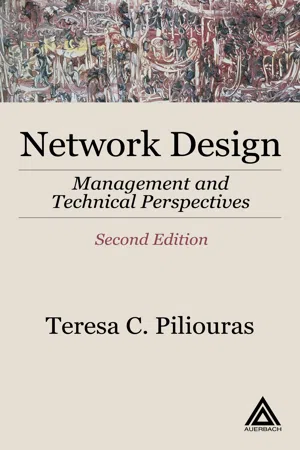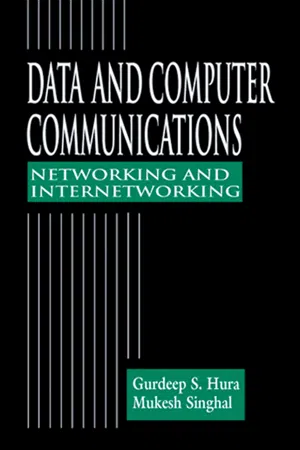Computer Science
Client Server Networks
Client-server networks are a type of computing system where client devices, such as computers or mobile devices, request services or resources from central servers. The servers store and manage data and applications, while clients access and use these resources. This architecture allows for efficient resource sharing, centralized management, and scalability in networked environments.
Written by Perlego with AI-assistance
Related key terms
1 of 5
8 Key excerpts on "Client Server Networks"
- eBook - PDF
Network Design
Management and Technical Perspectives
- Teresa C. Piliouras(Author)
- 2004(Publication Date)
- Auerbach Publications(Publisher)
353 Chapter 5 Client/Server and Distributed Networking 5.1 Overview of Client/Server and Distributed Object Networking Client/server networking distributes system processing across multiple computing devices. The ultimate client/server network is the Internet, which supports millions of distributed processes, operating across disparate time zones, geographic locations, and organizational boundaries. This chapter presents the major forms of client/server architecture, including two-tier, three-tier, and n-tier distributed network models. In legacy mainframe networks, there is a tightly controlled and syn-chronized master–slave relationship between the central computer and end-user devices. In contrast, client/server networks distribute processing functions between clients, which initiate and request services, and servers, which wait for and respond to client requests. Clients and servers are more loosely coupled, interacting through message exchanges. Thus, servers can be modified without disrupting clients, provided that the messaging interface between the two is not altered, and vice versa. This loosened coupling through a standardized, predetermined interface also provides the basis for allowing various software and hardware platforms to “peacefully” coexist in a client/server network. The major client/server networking standards (i.e., CORBA, COM+, and Web Services) define message interface conventions, and are distinguished by the degree to which they couple client and server implementation. 354 Network Design: Management and Technical Perspectives Distributed networks are a specialized form of client/server network. In a distributed network, no distinction is made between the client or server program. No longer is the server a passive participant that must wait for a client’s initiative. Rather, the clients and servers are interacting peers. - eBook - PDF
- Greg Tomsho(Author)
- 2019(Publication Date)
- Cengage Learning EMEA(Publisher)
Clients and Servers You’ve already learned about the role of client network software and server network software. Unfortunately, the world of networking sometimes uses the same terms to discuss two different things. The following sections clarify what “client” and “server” mean and how their meanings can differ depending on how they’re used. Client A client, in networking terms, can be a workstation running a client OS, such as Windows 10, or the network software on a computer that requests network resources from a server. In addition, you can refer to a physical computer as a client computer. What the term “client” means, therefore, depends on the context in which it’s used. To clarify, it’s typically used in these three contexts: • Client operating system—The OS installed on a computer is designed mainly to access network resources, even though it might be capable of sharing its own resources. Windows 10 and Mac OS X fit this description, for example, as do certain distributions of Linux. A client OS is also often referred to as a “desktop OS.” • Client computer—This computer’s primary role in a network is to run user applications and access network resources. Most computers in a network fit this description. Copyright 2020 Cengage Learning. All Rights Reserved. May not be copied, scanned, or duplicated, in whole or in part. Due to electronic rights, some third party content may be suppressed from the eBook and/or eChapter(s). Editorial review has deemed that any suppressed content does not materially affect the overall learning experience. Cengage Learning reserves the right to remove additional content at any time if subsequent rights restrictions require it. CHAPTER 1 Introduction to Computer Networks 36 • Client software—This is the software that requests network resources from server software running on another computer. For example, a Web browser, an e-mail client (such as the Gmail app), and Client for Microsoft Networks fit into this category. - eBook - PDF
Data and Computer Communications
Networking and Internetworking
- Gurdeep S. Hura, Mukesh Singhal(Authors)
- 2001(Publication Date)
- CRC Press(Publisher)
This type of data processing and manipulation in a distributed environment offers various advantages such as availability, placement of the data close to the source, etc. Its main disadvantage lies with singularity , which affects performance, portability, etc. But if we distribute the business application processing along with the distributed data across the network, then the distributed resources (PCs, workstations, etc.) can be effectively utilized (due to their excellent price/performance characteristics). Various components of the distributed appli-cation cooperate with each other in the processing of the business logic of the application. 20.4 Client–server computing architecture Client–server architecture, as shown in Figure 20.2, may be defined in a variety of ways, but we will consider the following definition, which by no means is a standard definition. Client–server architecture defines a computing environment where a network-based business application is divided into two processes (front end and back end) which run over multiple processors (client and server). These processors interact and cooperate (transparent to the user) with each other in such a way that the network application Figure 20.2 Client–server architecture. 986 Data and Computer Communications: Networking and Internetworking is completed as one unified task by them. Shareable resources are managed by the server processor, which offers services to the clients. The clients make a request to the server for data processing using a predefined language — structured query language (SQL) — over the communication network connecting clients and servers. The server, after processing the query, sends the results or reply back to the client. In some cases, the server may request another server to become its client (on behalf of the original client and so on), and the results or replies from its server are sent back to its original clients. - eBook - PDF
- Michael Gallo, William M. Hancock PhD CISSP CISM, William M. Hancock, PhD, CISSP, CISM(Authors)
- 2001(Publication Date)
- Digital Press(Publisher)
Thus, in a distributed system the file appears local to the user regardless of where the file actually resides within the system, whereas in a computer network the user must be cognizant of the file’s residence and then explicitly perform some function to gain access to the file. Although not exactly a computer network, there is considerable overlap between distributed systems and computer networks. Suffice it to say that a dis-tributed system represents a special case of a network, with the major distinction being the software as opposed to the hardware. 31. Now that I have some understanding of these legacy communication models, tell me about the current networking models that you mentioned earlier, namely, cli-ent-server, peer-to-peer, Web-based, and servent. OK. We’ll begin with client/server. Most network communications and applications today are based on a paradigm called the client/server model . This model describes net-work services (e.g., file transfers, terminal connections, electronic mail, and printing) and the programs used by end users to access these services. The client/server model can be thought of as dividing a network transaction into two parts: The client side (or front end) provides a user with an interface for requesting services from the network, and the server side (or back end) is responsible for accepting user requests for services and providing these services transparent to the user. Both terms—client and server—can be applied to either application programs or actual computing devices. 32. Please give me an example. Okay. Let’s assume you are using Microsoft Word on a networked PC. Let’s further assume that the printer you will use to print this document is a networked device accessi-ble by your PC. Thus, we have a common scenario in which an end user using an applica-tion program (Word) needs to access a specific network service (printing). - eBook - PDF
- Greg Tomsho(Author)
- 2015(Publication Date)
- Cengage Learning EMEA(Publisher)
This process continues until the packet arrives at the receiving application or service as the original data. This process is all part of the layered approach to networking. Clients and Servers You ’ ve already learned about the role of client network software and server network soft-ware. Unfortunately, the world of networking sometimes uses the same terms to discuss two different things. The following sections clarify what these terms mean and how their mean-ings can differ depending on how they ’ re used. Client A client , in networking terms, can be a workstation running a client OS, such as Windows 10, or the network software on a computer that requests network resources from a server. In addition, you can refer to a physical computer as a client computer. What the term “ client ” means, therefore, depends on the context in which it ’ s used. To clarify, it ’ s usually used in these three contexts: • Client operating system — The OS installed on a computer is designed mainly to access network resources, even though it might be capable of sharing its own resources. Windows 10, Windows 8.1, and Mac OS X fit this description, for example, as do certain distributions of Linux. A client OS is also often referred to as a “ desktop OS. ” • Client computer — This computer ’ s primary role in a network is to run user applications and access network resources. Most computers in a network fit this description. • Client software — It ’ s the software that requests network resources from server software running on another computer. For example, a Web browser, an e-mail client (such as Microsoft Outlook), and Client for Microsoft Networks fit into this category. Server When most people hear the word “ server, ” they conjure up visions of a large tower computer with lots of hard drives and memory. This image is merely a computer hardware configuration that may or may not be used as a server, however. - eBook - PDF
The Architecture of Computer Hardware, Systems Software, and Networking
An Information Technology Approach
- Irv Englander, Wilson Wong(Authors)
- 2021(Publication Date)
- Wiley(Publisher)
Both intranets and the Internet provide user access. The alternative architecture to client–server computing, peer-to-peer computing, is used outside of organizations as a means for sharing files over the Internet, but is of limited use in organizational settings due to difficulties in establishing stable data sources, security risks, and lack of central control. It is also possible to create a hybrid architecture, with features from both client–server and peer-to-peer computing. A number of autonomous computer systems, each with its own memory and I/O, can be loosely coupled into a cluster or a network. Clusters represent a form of loosely coupled 450 MODERN NETWORKED COMPUTER SYSTEMS system in which computers are interconnected with high-speed messaging links. A cluster consists of multiple computers acting as one. Shared-nothing clusters utilize separate disks and data partitioned and distributed among the systems in the cluster. Shared-disk systems provide multiple system access to one or more shared disks that hold the data to be pro- cessed by all. Network file access is accomplished using files that are attached to servers or by using a storage area network. Files that are attached to servers are accessed either by aliasing a name or by mounting the directories locally. The server acts as an intermediary for files that are stored on an SAN. The services provided by Web-based servers can be extended using cloud-based services. In addition to simple off-site storage, these include services at the software, desktop, plat- form, and infrastructure level. There are many advantages in the use of cloud-based services with risks mitigated through the use of multi-clouds. Supercomputing utilizes large num- bers of interconnected CPUs or computers to provide large amounts of computing power. The three primary technologies are clustering, cloud services, and grid computing. - eBook - ePub
Engineering Informatics
Fundamentals of Computer-Aided Engineering
- Benny Raphael, Ian F. C. Smith(Authors)
- 2013(Publication Date)
- Wiley(Publisher)
With the now ubiquitous presence of the World Wide Web (WWW), the terms ‘web browser’ and ‘web server’ have become widely known. Perhaps less familiar is the idea that the Web conforms to the classical client–server architecture. The web browser is the client and (as the name implies) the web server is the server. The browser sends requests for files to the web server. The web server supplies the files requested by the browser. Browsers usually have a GUI for properly displaying files and letting users interact with them. More details are given in Section 13.7.13.2.9 Application Servers
Application servers perform specialized computations. These are custom applications that are developed for specific requirements. An example is the cost computation server discussed earlier.13.3 Distinctive Features of C/S Systems
Client–server systems are a form of distributed computing. There are other forms such as those used in parallel processing machines and machine clusters. Features that distinguish C/S from other forms of distributed computing are an asymmetrical protocol and a message-based mechanism.13.3.1 Asymmetrical Protocol
The term ‘asymmetrical protocol’ implies these three properties:- Clients always initiate the interactions; servers are passive listeners.
- Servers remain alive for a long time; clients are usually short-lived.
- There is usually only one server but multiple clients (Figure 13.6 ).
Figure 13.6There is usually a single server and multiple clientsThis architecture is similar to the model that we follow in shops and restaurants. Shops remain at the same location for a long time, whereas clients come and go. Shop owners advertise their products, but it is the client who initiates a transaction by requesting a product or service.13.3.2 Message-Based Mechanism
Within a conventional stand-alone program, information is exchanged through the computer's main memory. For example, when computing the sum of a set of numbers, a program might make a procedure call and pass the numbers as parameters. The parameters of a procedure are stored at some location within the computer's working memory. The procedure obtains the values of all parameters by reading this memory. The result of the procedure is also returned to the calling function in a similar manner. This approach differs from a C/S program that performs computations by sending messages. - eBook - PDF
- Gilbert Held(Author)
- 2000(Publication Date)
- Auerbach Publications(Publisher)
25 Chapter 0-8493-9823-1/00/$0.00+$.50 © 2000 by CRC Press LLC 3 What Does a Server Do? A General Overview Kristin Marks INTRODUCTION This chapter is for beginning network managers who want to make sure they have a grounding in the fundamental basics before they get lost in the alphabet soup of the more advanced technologies. Servers are considered the heart of any network. So before we get too far into all the different server issues, let’s look at the very basic concepts that define what servers do and where servers fit into the larger network picture. UNDERSTANDING NETWORKS Networks exist to serve users, hence, the origin of the term server for a sys-tem that provides services. You have two jobs: 1. Learn the basic terms used in computer networking. 2. Understand the several possible network services along with how they can be implemented. Let’s start by defining just what networking is. At its most basic level, net-working is sharing resources, which can include information or functional capabilities. Computer networking extends that sharing with communica-tion tools that let our computers share resources. Centralized Computing At the very beginning (we’re talking 1940s here), electronic computers were huge machines that used thousands of vacuum tubes (this was back in the dark ages before transistors and the large-scale integrated circuits we use today); a single computer system could consume the entire output of an electrical generating station. Governments, educational institutions, 26 THE ROLES OF THE SERVER and large corporations were the only places where these systems could be found, largely because no one else had the resources to build or buy them. By necessity, computing in its earliest form was centralized around these large “mainframes” used to store and organize information. Inputting data was done with terminals that featured input devices like keyboards.
Index pages curate the most relevant extracts from our library of academic textbooks. They’ve been created using an in-house natural language model (NLM), each adding context and meaning to key research topics.







